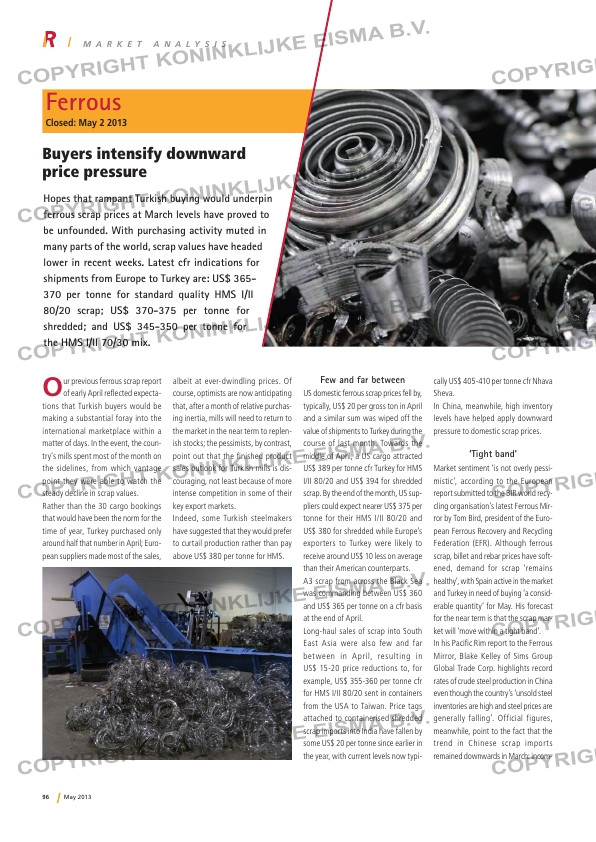Page 96 from: May 2013

96 May 2013
m a r k e t a n a l y s i s
Ferrous
Buyers intensify downward
price pressure
Hopes that rampant Turkish buying would underpin
ferrous scrap prices at March levels have proved to
be unfounded. With purchasing activity muted in
many parts of the world, scrap values have headed
lower in recent weeks. Latest cfr indications for
shipments from Europe to Turkey are: US$ 365-
370 per tonne for standard quality HMS I/II
80/20 scrap; US$ 370-375 per tonne for
shredded; and US$ 345-350 per tonne for
the HMS I/II 70/30 mix.
Closed: May 2 2013
Our previous ferrous scrap report of early April reflected expecta-
tions that Turkish buyers would be
making a substantial foray into the
international marketplace within a
matter of days. In the event, the coun-
try’s mills spent most of the month on
the sidelines, from which vantage
point they were able to watch the
steady decline in scrap values.
Rather than the 30 cargo bookings
that would have been the norm for the
time of year, Turkey purchased only
around half that number in April; Euro-
pean suppliers made most of the sales,
albeit at ever-dwindling prices. Of
course, optimists are now anticipating
that, after a month of relative purchas-
ing inertia, mills will need to return to
the market in the near term to replen-
ish stocks; the pessimists, by contrast,
point out that the finished product
sales outlook for Turkish mills is dis-
couraging, not least because of more
intense competition in some of their
key export markets.
Indeed, some Turkish steelmakers
have suggested that they would prefer
to curtail production rather than pay
above US$ 380 per tonne for HMS.
Few and far between
US domestic ferrous scrap prices fell by,
typically, US$ 20 per gross ton in April
and a similar sum was wiped off the
value of shipments to Turkey during the
course of last month. Towards the
middle of April, a US cargo attracted
US$ 389 per tonne cfr Turkey for HMS
I/II 80/20 and US$ 394 for shredded
scrap. By the end of the month, US sup-
pliers could expect nearer US$ 375 per
tonne for their HMS I/II 80/20 and
US$ 380 for shredded while Europe’s
exporters to Turkey were likely to
receive around US$ 10 less on average
than their American counterparts.
A3 scrap from across the Black Sea
was commanding between US$ 360
and US$ 365 per tonne on a cfr basis
at the end of April.
Long-haul sales of scrap into South
East Asia were also few and far
between in April, resulting in
US$ 15-20 price reductions to, for
example, US$ 355-360 per tonne cfr
for HMS I/II 80/20 sent in containers
from the USA to Taiwan. Price tags
attached to containerised shredded
scrap imports into India have fallen by
some US$ 20 per tonne since earlier in
the year, with current levels now typi-
cally US$ 405-410 per tonne cfr Nhava
Sheva.
In China, meanwhile, high inventory
levels have helped apply downward
pressure to domestic scrap prices.
‘Tight band’
Market sentiment ‘is not overly pessi-
mistic’, according to the European
report submitted to the BIR world recy-
cling organisation’s latest Ferrous Mir-
ror by Tom Bird, president of the Euro-
pean Ferrous Recovery and Recycling
Federation (EFR). Although ferrous
scrap, billet and rebar prices have soft-
ened, demand for scrap ‘remains
healthy’, with Spain active in the market
and Turkey in need of buying ‘a consid-
erable quantity’ for May. His forecast
for the near term is that the scrap mar-
ket will ‘move within a tight band’.
In his Pacific Rim report to the Ferrous
Mirror, Blake Kelley of Sims Group
Global Trade Corp. highlights record
rates of crude steel production in China
even though the country’s ‘unsold steel
inventories are high and steel prices are
generally falling’. Official figures,
meanwhile, point to the fact that the
trend in Chinese scrap imports
remained downwards in March: incom-
RI-4_Analysis Ferrous.indd 96 03-05-13 14:22



